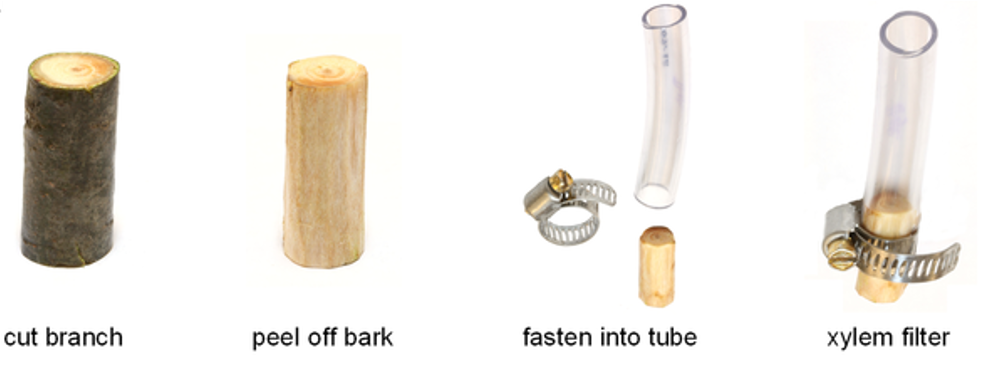Make your own Xylem Water Filter

Cut, debark, fasten…
ready to filter!
Caution: Confirm that the tree is non-poisonous! For example, yew is poisonous and should not be used. Follow safety precautions during cutting. Drinking water from home-made filters is not recommended unless they are subjected to appropriate quality control measures and comply with safety standards.
Background information for experiments
What is xylem?
Plants use the xylem tissue in trunks and branches for transporting water from roots to other parts. Evaporation of water from the leaves creates a negative pressure in the xylem and pulls the water from the roots towards the leaves.
What does the xylem tissue look like?
The xylem has a very interesting structure. It consists of conduits, which are inter-connected to one another through pores present on their sidewalls. These pores range in size from a few nanometers in angiosperms to a few hundred nanometers in gymnosperms. They are much smaller than several contaminants present in water such as dust, bacteria and protozoa.
Ok, but how does this help me create a water filter?
A section of branch that is longer than a single conduit in the xylem will force the water to pass through the pores, which can entrap contaminants. This piece of branch can therefore function as a water filter.
So, do the plants also use the xylem for filtering water?
No, the primary function of the pores in the xylem is to prevent disruption of water transport in plants. Since the water in the xylem is transported at negative pressure, there is a risk of formation and growth of vapor bubbles. These vapor bubbles can disrupt water transport and kill the plant if not kept in check. The pores trap the bubbles, prevent their propagation, and ensure smooth water transport in plants.
Can I create a water filter using xylem from any tree?
Gymnosperms or non-flowering plants like pine, cedar, spruce, etc. (that are non-poisonous) are better suited for creating filters than angiosperms or flowering plants. This is due to two main reasons:
1. The xylem constitutes a greater fraction of a branch or trunk cross-section in gymnosperms than angiosperms, thus making more area available for filtration.
2. The conduits in gymnosperms are a few millimeters in size and are much smaller than those in angiosperms, where they could be centimeters or even a few meters long. As filters have to be longer than a single conduit to ensure water passage through the pores, filters made from gymnosperms are relatively more compact.
Great! Now, how do I create my own water filter?
Well, here’s what you need:
1. A section of branch from a non-flowering tree (like pine, cedar, etc.), at least a quarter-inch thick
2. Hose/tube to mount the branch
3. Clamp to seal the branch within the hose/tube
4. Feed solution to test the filter (could use dirty water or create your own feed solution by adding dust to clean water, diluting yogurt, etc.)
The video above shows how you can create filters and also illustrates a demonstration activity. Make sure that the filter is made from green wood and is kept wet throughout your experiment!
Dive deeper into your experiments
How does the flow rate depend on filter area and thickness?
Does the flow rate change with pressure? If so, how?
Do flow rates and contaminant removal vary across different trees?
How does the contaminant removal efficacy of the filter change with contaminant size?
How much water can a filter process? And how does it depend on water quality?
What happens to the flow rate if you dry the filter? Can you explain why?
